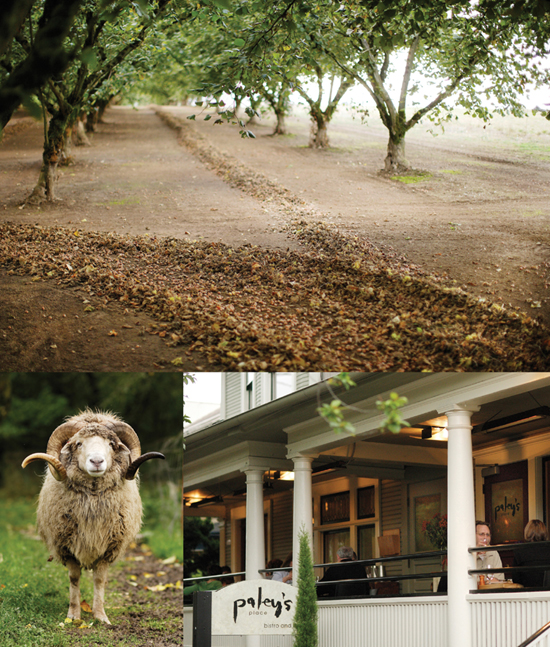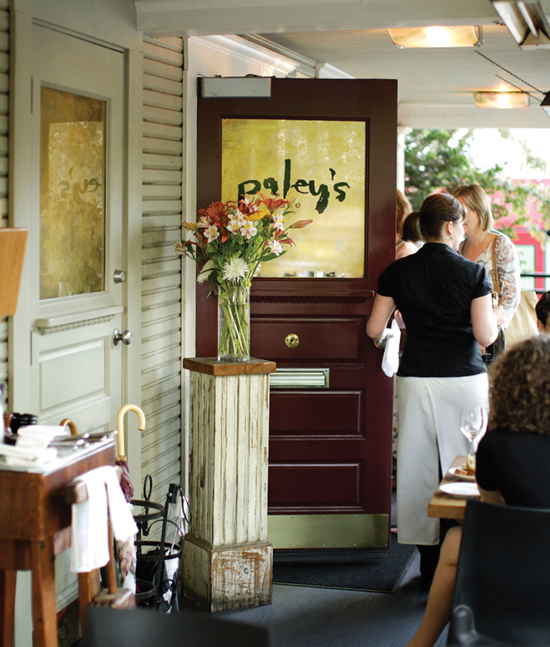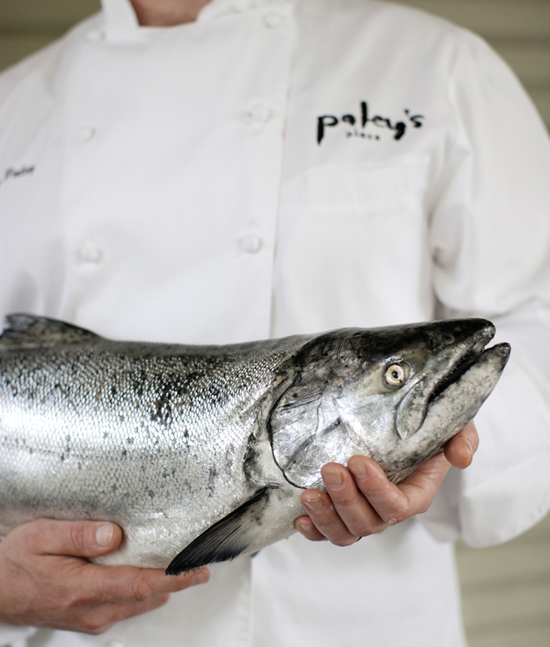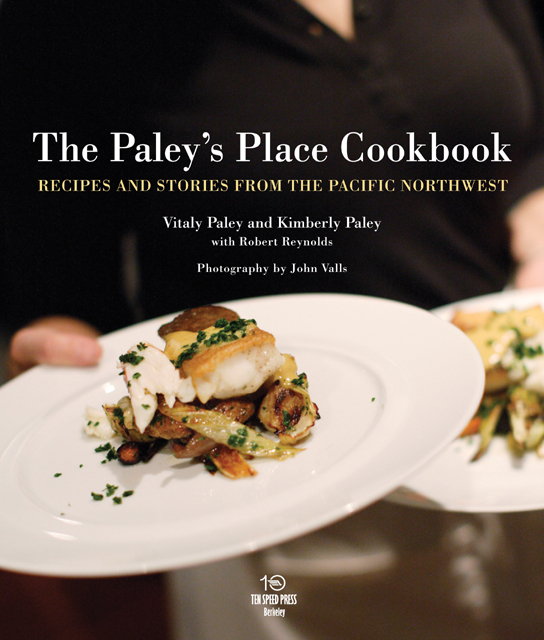
Copyright 2008 by Vitaly Paley and Kimberly Paley
Photography 2008 by John Valls
All rights reserved.
Published in the United States by Ten Speed Press, an imprint of the Crown Publishing Croup, a division of Random House, Inc., New York.
www.crownpublishing.com
www.tenspeed.com
Ten Speed Press and the Ten Speed Press colophon are registered trademarks of Random House, Inc.
Cover design by Betsy Stromberg
Library of Congress Cataloging-in-Publication Data
Paley, Vitaly.
The Paleys Place cookbook : recipes and stories from the Pacific Northwest / Vitaly Paley and Kimberly Paley, with Robert Reynolds;
photography by John Valls.
p. cm.
Includes index.
eISBN: 978-1-60774-508-2
1. Cookery, AmericanPacific Northwest style. 2. Paleys Place Bistro and Bar. I. Paley, Kimberly. II. Reynolds, Robert. III. Title.
TX715.2.P32P3157 2008
641.59795dc22
2008021668
v3.1_r1
For Merle Clinton Brown


Contents


Introduction

Close to Home: Cooking in the Pacific Northwest
by VITALY PALEY
T he story of Paleys Place began in New York, where Kimberly and I met. She was a dancer who had come from California to study at the Martha Graham School. Born in Russia, I had come to New York as a teenager and now, in the eighties, was studying music at Juilliard. Like many of our friends, we subsidized our art by working in the food world, and we met when we were both managers for a dinner cruise company. One July Fourththe 100th birthday of the Statue of Libertywhen our work was done for the night, we wound up making out in the shadows of the torch the old Dame held high. We remember fireworks.
Looking back, we think we chose food over art, but perhaps it was fate, and food chose us. I went to the French Culinary Institute in New York, and together we moved to France to work and learn together at a Michelin-starred restaurant called Au Moulin de la Gorce, near Limoges. Back in New York, we worked with the best, including Tom Valenti at Alison on Dominick, David Bouley of Bouley, Michael Romano and Danny Meyer of Union Square Caf, and David and Karen Waltuck of Chanterelle. Kimberly studied with Kevin Zraly at Windows on the World, Andrea Immer, and master sommelier Roger Dagorn.
But it was in our tiny Bleecker Street apartment that our vision for the restaurant that would become Paleys Place began to shape itself. In the spirit of collaboration that we still share, we invited friends and family to dinnersand not just any dinners. On each occasion, we created experiences that reflected whatever inspired us about a particular menu. We wrote invitations, specifying a dress code for the eveninginformal or jacket and tie. Kimberlys hospitality was unstinting, her eye for detail meticulous. She set the stage, making menus by hand and dressing the table with silverware arranged face down, as she learned to do in France and as she still does in the restaurant. If I plucked basil from clay pots on the fire escape, Kimberly described it on the menu as local, a nod to the lessons we learned in France and a sweet gesture toward our yet-unwritten future in Portland, in the cool, open West.
After one summer too many in hot, airless, underground restaurant kitchens (me) and coping with the behind-the-scenes madness of restaurant dining rooms (Kimberly), we sold our apartment on Bleecker Street, packed up, and left New York knowing two things: we wanted our own restaurant, and we wanted it to be in Oregon.
doesnt refer to the chef, but to the farmer, George Weppler.
In anticipation of moving to Oregon, we had already made connections with winemakers Ken Wright (then of Panther Creek and now of Ken Wright Cellars) and Russ Raney of Evesham Wood. Once here, we discovered food producerslike George Weppler and cheesemaker Pierre Kolish of Juniper Grove Farm in Redmondwho we feel are visionaries.
Over the years since we opened Paleys Place, we have come to feel that we have not just created a restaurant, but are participating in a bigger movement to establish the uniqueness of Oregon, a region that has figured out how to sustain the integrity of its agricultural traditions. Unlike France, Oregon doesnt have an Appellation dorigine contrle (AOC) system as a guarantee of superior quality. But Oregons producers make a certain kind of promise among themselves: when they say the berries are good, they mean it.
In this book, as in our restaurant, we have tried to bring out the stories of the people who provide us with impeccable ingredients. Their stories reflect the way we strive to do business; their engagement matches ours, and therefore fosters respect each time we touch what they provide. In these pages you will get a glimpse of the growers, foragers, fishermen, and artisan producers who provide us with lamb, mushrooms, potatoes, greens, nuts, cheese, salmon, and more. Other stories in these pages are meant to shed light on some of the culinary techniques and influences, hospitable spirit, and threads of memory that tie our past experiences to our present.
Our approach to food and wine and the dining experience is deeply personal. The recipes and stories in this book reflect how and why we do what we do with these products in this place. In the end, it is all about relationships. It starts with Kimberly and meour collaboration is an endless source of inspiration for both of us. Our relationships with our customers, our purveyors, and our staff are gifts. Without them, this story would be very different.
Cooking seasonally does not come naturally to most of us. We can buy anything at any time of year, and that path of lesser resistance is always easier to follow. The foods we buy have to be seasonal somewhere, right? But defrosted fish is not the same as fresh off the boat, and an out of season tomato or ear of corn can never compare to just picked. Let your senses guide you to what smells and feels real rather than what looks shiny and flawless. If you search out locally produced and grown goods whenever possible, chances are they will be seasonal as well.
In the kitchen, trust your senses to help you take a dish to its logical conclusion rather than blindly following the recipe. Experience has taught me that achieving a perfect balance of flavors is a learned skill. Each dish can attain a sweet spot, however elusive it might be, and you learn where it is by tasting.
I am constantly reminded of my final exam in cooking school, where I had to reproduce several classic French recipes. I was a good student and I knew them all by heart, so making them was easy, I thought. When I presented the finished dishes to the panel of judges, I received a less-than-enthusiastic critique. I had followed the recipes exactly as I had been taught to do them. So what went wrong? One judge asked me if Id tasted what I made. There and then it all made sense. Ive never forgotten that lesson. I urge you to taste, taste, and taste what youre cooking at every stage. Learning to follow flavors as they unfold will help you navigate through written instructions and will eventually educate your senses and produce impressive results.












